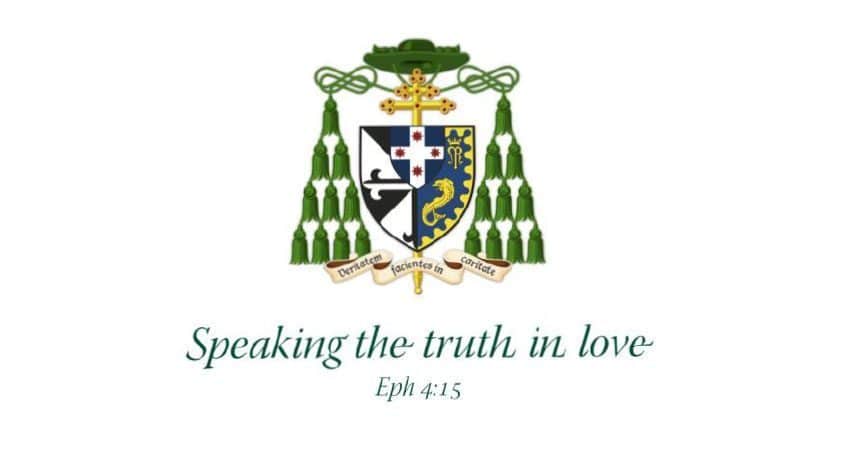Homily for Mass of the 5th Sunday of Lent, Year B + Opening of Catholic Institute of Sydney Academic Year

St Mary’s Cathedral, Sydney, 17 March 2024
“Sir, can we please see Jesus.” (Jn 12:20-33) They were Greeks who had come up to Jerusalem for Passover. They approached Philip because he spoke Greek like them. By now Jesus was the hottest ticket in town—the ancient near-eastern Taylor Swift—and to get near Him you needed connections. He was famed for His miracles, teachings, personality. The Gospel of John highlights seven signs in particular: turning water into wine; healing the dying son of an official; curing a cripple at the sheep-gate pool; feeding the five thousand; walking on water; giving sight to a man born blind; and raising a man from the dead.[1]
With each miracle comes a teaching: at Cana we learn that the cleansing water of the old dispensation is transformed into the sacramental spirit of the new; on a hill in Galilee multiplied loaves occasion teaching on the Eucharist; in Jerusalem the healing of a blindman, about spiritual blindness; in Bethany the raising of Lazarus, wisdom about eternal life. And with each teaching we gain greater understanding of who Jesus is for us: Miracle-worker, Teacher, Prophet, Messiah, Judge; Bread of Life, Light of the World, Good Shepherd, Resurrection and Life; King of the Jews, Beloved Son of God, the I am.
: The background to today’s teaching by Jesus is the last of His great signs: the raising of Lazarus of Bethany. In provoking His teaching about the Resurrection it was a fitting entrée to Holy Week. And sure enough, plots were quickly hatched against both Jesus and Lazarus; Jesus was anointed by a woman of Bethany to prepare Him for burial; and His Palm Sunday entry into Jerusalem, though no miracle, caused a similar sensation—and a similar reaction from the authorities.
What were the Greeks hoping for in asking for an audience with Jesus amidst all this? Jesus had indicated that His focus was on Israel, not foreigners, yet He demonstrated a care for all people. The first generation of Christians would take some time to resolve whether the mission was to the Jews only or to all nations.[2] Perhaps the Greeks who approached Jesus’ agent Philip hoped to draw more attention to the faithful of the gentile nations, the ‘outsiders’.
: There’s lots of talk these days about diversity, equity and inclusion. It seems to have taken the place of integrity, ethics and trust. Those who talk big about DEI are often the most inclined to exclude people who think differently to them, while being expert in identifying other people’s failures in diversity. We can hear them complaining today: “Jesus and company, you guys are great in including women as well as men, healed cripples, children and others. But you spend most of your time around Jerusalem and the Temple, or Galilee and other comfortably Jewish places—occasional wanderings in the Decapolis or conversations with Romans and Samaritans notwithstanding. If the Good News is for everyone, you need more ethnic diversity!” It was a bit late to be redesigning Jesus’ mission: He would be dead within the week. But after the Resurrection He would indeed send His followers out (Mt 28:19f; Mk 16:15ff; Acts 1:8), much like the way a burning eucalypt will release germinating seeds to the four winds.
Whatever their motives, the Greeks got Jesus’ attention. But I suspect they found His response rather bamboozling. Jesus launches into an unsettling reflection for Holy Week: “As I face my pending doom, my soul is troubled. The Son of Man will be glorified by being lifted up on the cross. He must die and be buried, like grain seeded in the earth, if there is to be a rich harvest. So shall I draw all people to myself.”
Most of the buzz around Jesus up to this point was about His miracles, teaching, personality. All three pointed to deeper things, about repentance, compassion, holiness in God’s kingdom. Yet what grabbed people first was the razzamatazz of the miraculous, the warm and fuzzies felt as He spoke, the star quality of Christ Himself. If the Greeks wanted to really see Jesus in the climactic last week of His life, He was going to have to be very direct with them: “To join me is to follow me, all the way to the cross and tomb. Clinging to your life only wastes it, sacrificing it (as if it were hateful) is what saves it.” Be careful what you ask for, you Greeks!
When we think of Christ only as wonderworker, inspirational speaker or great includer, we glimpse Him at most partially. When we tame His Gospel so it consoles but does not challenge us, it’s only a mirage. When we refashion Him into something palatable to our taste or ideology, we are looking at a mirror, not at Him. The reality of Jesus is comforting but also confronting. Even He recoils momentarily today from the enormity of what the Father asks: “Father, save me from this hour,” He pleads, the prayer of His last night in the Garden of Gethsemane. But then He recalls that this terrible hour is the very reason He had come—and the Father thunders His approval from heaven.
The Catholic Institute of Sydney has an important role in keeping us honest in these matters here in Sydney and beyond. In forming seminarians and deacons to be our future clergy, in educating lay people also in theology and related disciplines, in engaging in quality theological research, it calls us to see the real Jesus Christ, beloved Son of the Father, lifted up for our sake. Serious theology will be both consoling and challenging, will speak from the heart of the Church and send us out to the peripheries, will unite faith and reason, heart and mind in the ascent to God. It will resist our all-too-human tendencies to domesticate the mystery, reduce the demands, follow the fashion. Catholic theology recalls us to the One who humbly submitted to the Father’s will and showed us the path to follow also (Heb 5:7-9).
The hour approaches for the Son of Man to be lifted up from the earth and glorified—on the Cross, at the Resurrection, by the Ascension. Only in that act of perfect love will He draw all of us, all humanity, to Himself. Only then, gazing on the Son of Man in agony, shall we glimpse His real glory—the glory of self-sacrifice for God and humanity. Our response to this is in fact our last judgment. “Now is sentence being passed on this world.”
[1] Theseven signs: turning water into wine at Cana (Jn 2:1-12); healing the official’s dying son (Jn 4:46-54); healing the cripple at the sheepgate pool (Jn 5:1-15); multiplication of loaves and fishes (Jn 6:1-14); walking on water (Jn 6:15-21); healing the man born blind (Jn 9:1-38); and raising Lazarus from the dead (Jn 11:1-44).
[2] Jesus’ focus on the children of Israel: Mt 10:5f; 15:24; Jn 4:22; Acts 2:26. Jesus’ care for all people: Mt 2:1f,32; 8:5-13,28-34; 10:18; 12:18; 15:21-28; 21:33-45; 26:12f,28; 28:18ff; Lk 17:12-19; Jn 4:5-42; 12:32. In the next generation: Acts 1:8; 8:5-8; 9:15; 10:1-11:18; 11:20; 13:46f; ch. 15; 18:6; 22:21; 26:17-23; 28:28; Rom 1:14,16; 2:10; 11:13; 15:8f,16; Gal 2:7-8.
Introduction to Mass of the 5th Sunday of Lent, Year B + Opening of Catholic Institute of Sydney Academic Year – St Mary’s Cathedral, Sydney, 17 March 2024
Welcome to St Mary’s Cathedral in Sydney for the Solemn Mass of the 5th Sunday of Lent. Our Lenten journey is almost at an end, and our sights set on Calvary, source of our salvation. As we enter the final straight, we intensify our prayer and penance, charity and confession, that we might be ready to rise with Christ at Easter.
Today we mark the opening of the 2024 Academic Year for the Catholic Institute of Sydney. I acknowledge concelebrating with me today our birthday boy and Deputy Chancellor Most Rev. Bishop Richard Umbers, with several members of the senate. From the Archdiocese, Auxiliary Bishop Most Rev. Danny Meagher. From the Seminary of the Good Shepherd, the Rector Very Rev. Fr Michael De Stoop, with his team of formators; from the Redemptoris Mater Seminary, the Rector Very Rev. Fr Eric Skruzny; from the Office for the Permanent Diaconate, Deacon Aisavali Salu; from the faculty of the Institute, Fathers Very Rev. Peter Williams VG, Rev. Dr Gerard Kelly, Rev Dr. Luke Holohan SM, and Very Rev. Dr Julian Wellspring JV who is another birthday boy today. ; From Vianney College Seminary Wagga Wagga, we welcome back the Vice-Rector Rev. Fr Bradley Rafter.

